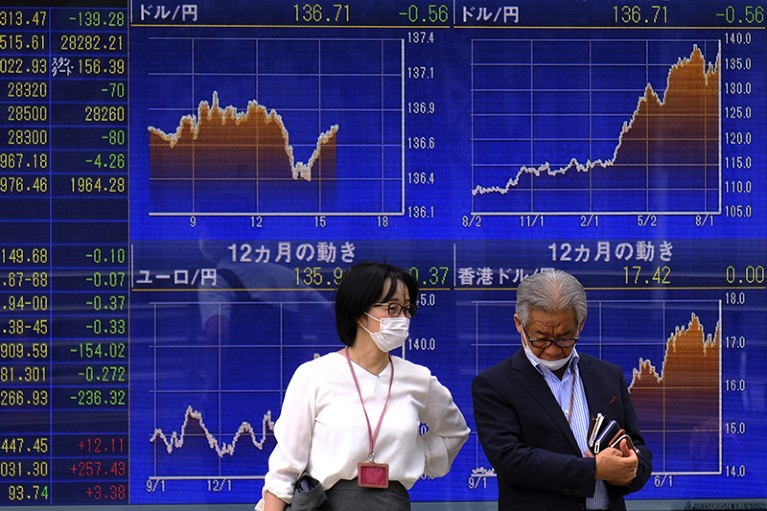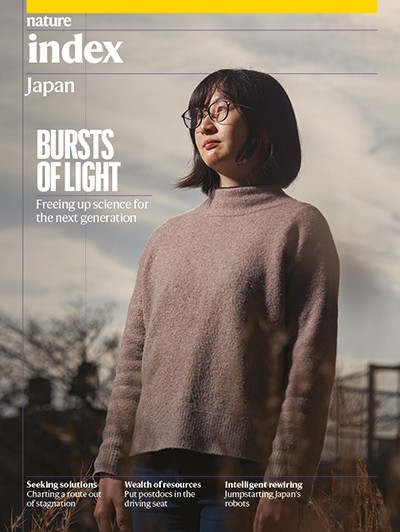
Japan’s stock market doesn’t function under normal conditions, because the government has been artificially inflating its pension fund investment.Credit: James Matsumoto/SOPA Images/LightRocket via Getty
Large endowment funds underpin the stability and independence of some of the world’s most successful research institutions. Take Harvard University, the leading academic institution globally by Share in the Nature Index. Harvard has one of the world’s largest endowments for an academic institution at more than $50 billion, a sum that allowed the fund to contribute $2.1 billion to the institution’s operating budget from 2021 to 2022.
These endowments are usually made up of donations from private individuals; in the case of Harvard, the overall endowment includes thousands of separate charitable funds. Proponents say such endowments can give institutions a degree of freedom to pursue the scientific research they wish without the political interference that may come from relying entirely on government funding.
Nature Index 2023 Japan
Inspired by this model, Japan unveiled plans in 2021 for a ¥10-trillion (US$75-billion) national endowment fund. The aim, say its architects, is to spur innovation and improve governance. But some academics have criticized the plan, warning that its creation by the government will allow it to meddle in academia, the very thing that Ivy League-style endowments are designed to avoid.
Japan’s Ministry of Education, Culture, Sports, Science and Technology (MEXT) cites the nation’s “declining research capabilities” as the drive behind the fund. China, by comparison, has achieved a dramatic 89% leap in high-quality research output, as measured by adjusted Share in the Nature Index, from 2015 to 2021. Chinese research institutions are making major strides in physical sciences and chemistry, overtaking the United States in the former category on Share for the first time in 2021.
Year-on-year rises in Chinese research and development spending as a percentage of the county’s GDP are underpinning its ascendency, but Japan’s expenditure remains relatively flat as a proportion of its national income.
Public spending on tertiary education in Japan, meanwhile, was just 0.5% of GDP in 2019 (the United States spends 0.9%: France and Germany spend twice that). Government funding for national universities, where most of Japan’s leading science and technology research is carried out, has been cut by about 1% per year since they were freed from direct government control and partially privatized as part of sweeping reforms in 2004. This amounts to a total fall from ¥1.24 trillion in 2004 to ¥1.08 trillion in 2022.
Modest returns
MEXT now wants to nudge Japanese universities towards the US endowment funding model, forcing them to be more self-sustaining. Harvard’s fund delivered a 33.6% return in the year to June 2021 (although such returns can easily fluctuate: it had a negative return of 1.8% last year). By contrast, the endowment fund of one of Japan’s top higher-education institutions, the University of Tokyo, was around ¥19 billion in the year to March 2021, less than 0.5% of Harvard’s total fund. Many other prestigious universities in Japan earn little or nothing from investments.
Takahiro Ueyama, a member of the government’s Council for Science, Technology and Innovation, and a key architect of the endowment fund, says Japanese universities cannot compete with such generously funded foreign rivals. And, in a country with the worst GDP–debt ratio in the G7, the public “will not accept” pouring more tax money into research.
The fund, set up with ¥10 trillion from the government, will start operating from the 2024 fiscal year. The money will be invested in equities and bonds and venture-capital stocks for a projected payout of 3% per year. Universities accepted on to the scheme, probably between four and six, according to Ueyama, would share the profits from the estimated ¥300 billion a year earned from the fund. MEXT criteria for institutions wanting to take part include having “research capabilities for international excellence” and an “autonomous and responsible governance structure”.
Ueyama says the estimated annual return is modest, but critics argue that the government forecasts are too optimistic. Japan’s stock market doesn’t function based on normal market conditions because the government has been artificially inflating its pension investment fund by buying stocks from the Bank of Japan, explains Takeshi Komagome, an education policy expert at the University of Kyoto. Without similar cash injections in the future, it’s difficult to imagine big investment returns, he says. Komagome says the new initiative is effectively a confidence trick. “It looks good on the surface, but it won’t deliver any extra money.”
Then there is the issue of who will get funding. MEXT estimates that only a dozen or so universities will make the criteria, which include having affiliated authors on at least 1,000 research articles in the five years from 2016 to 2020. Universities will be further whittled down via a rigorous application and screening process.
“I am not sure how such a big offer to only limited universities that have already had financial power helps the market for higher education to be more competitive,” says Sawako Shirahase, a sociologist at the University of Tokyo and vice-president of the International Science Council.
Culture crisis
Akiyoshi Yonezawa, director of the Office of Institutional Research at Tohoku University, predicts that the MEXT plan could have a positive impact on research universities. But he adds that despite its size, the fund is still too small to help Japan catch up to the top institutions in the United States. In any case, he says, the organizational transformation of Japanese universities needs to continue if they are to become globally competitive.
Reformers have long criticized Japanese universities for spending too much time on meetings and not enough on research, widely attributed to a management style that prioritizes faculty consensus on all decisions. They say the hierarchical management at major universities also stifles the careers of younger researchers. Kiyoshi Kurokawa, professor emeritus of the University of Tokyo and the National Graduate Institute for Policy Studies, says the mindset of Japanese institutions is still too vertical with a high proportion of senior researchers and leaders being graduates of their own institution. “I encourage universities to send more graduate students to the US and the UK, maybe China, Australia, not up the vertical ladder at their own universities,” he says.
Others agree that Japanese research needs more than just an influx of money. Glen Fukushima, a former adviser or board member to several top Japanese universities, is one of many observers who has given a bleak assessment for higher education in Japan owing to its insularity and governance. He is optimistic, however, that the fund could spark change, particularly in science, technology, engineering and maths fields. “I have some hope that Japan can improve its international standing if the money is used strategically and researchers with talent and potential can be developed,” he says.
There are also concerns that the process for identifying universities to benefit from the fund is too open to political influence. It has been noted that a panel set up by Japan’s cabinet office, including the prime minister, will advise MEXT on selecting institutions. “This is very unusual,” says Komagome. “It will hand over political control of universities to the government.” Komagome predicts that education unions will fight the MEXT proposals because they believe they will lead to universities prioritizing subjects that bring in more tuition-fee revenue, forcing social sciences and arts departments to close, or to fund projects that have political support, such as military research.
Tensions may be running high because the government was heavily criticized in 2020 after it rejected six nominees for the Science Council of Japan on what many academics perceived to be political grounds. Academics have also grown increasingly wary of what they see as government attempts to appoint people who support their policies to other advisory councils.
But Ueyama insists that politicians should have no role in directing research. The ultimate aim, he says, is the opposite: to create independent research universities free of interference. The government has to be involved in the initial stages of setting up the fund as “universities here have no know-how about endowments”, he says. The government’s role is to help them catch up, then to bow out.
Despite the criticisms, many academics are giving the fund a cautious thumbs-up, praising it for its ambition and boldness, but urging deep reform of research methods. In an opinion article for Asahi Shimbun last September, Fujio Omori, an education policy expert at Tohoku University, said the fund would have little effect unless undergraduate teaching is reformed and moved away from passive learning. “The methods of the US and other countries that are ahead of us can be used as a reference,” he wrote. Whatever happens, says Ueyama, Japan must move quickly. “This is going to be our final chance to transform higher education in this country.”


